|
|
A Flying Trip Into The Catskills
Memorable Neighborhoods In Greene County
By H. Schile
Webmasters note: I have decided to leave the title of this article as it appeared in the book, although I have no idea why he calls it a "flying trip".
|
THE most interesting trip is a visit to the well-known Catskill. You can reach the village by way of the Hudson River Railroad, or by the Albany steamers. Having arrived there, refreshments can be obtained at the Irving House, whose hospitable and obliging landlord never fails to secure his guests an excellent fare at very reasonable terms. Another hotel which deserves to be mentioned, is the Prospect Park Hotel. This is the only place which, situated at a high point, can be recommended to those who desire to spend a summer season here, since the air is ever cool and balmy, and a magnificent view can be enjoyed over the Hudson; and in the opposite direction there is a fine panoramic scene, — the village in the foreground and behind it the Catskill Mountains.
It was on an exceedingly warm spring day that I first visited this beautiful country, and must confess that I found it here absolutely scorching, and the deeper you enter the village, the more oppressive becomes the heat. Just above the village, where the principal summer resorts are situated, the temperature is the highest, and it is entirely beyond my comprehension what pleasure can be found in these localities, where one can do nothing but perspire all day long. I pity those people who, with their fixed notions to visit the so-called " fashionable " hotels, have no regard for their comfort and health, but allow themselves to swelter in the burning rays of the sun. I even met some there who were so sunburnt, that they looked like boiled lobsters. Not even a good draught of fresh, cool spring water can be obtained there, which makes the oppressiveness of the heat doubly felt. Towards evening, the long-legged musicians, the mosquitos, make their appearance, and perform their entertaining concerts. The best thing one can do on such days is to engage a seat on a passing stage, and to turn his back on these places. The fare on the stage, all the way up to the Laurel House, is only two dollars. Close by the house is a primeval forest, and the Kaaterskill Fall. This neighborhood is therefore always cool. From the village, the road turns to the left, and from hill to hill. It is not only good all the way, but also cool and shady.
The views are beyond expression—fine and picturesque in their effect. High up before us we constantly have the beautiful Mountain House in view, and the beautiful bluish tint of the mountains approaches nearer and nearer, till, having arrived at the entrance to the Cauterskill Clove, all this view is lost to sight, and an entirely new picture is spread before our eyes. Turning into the Clove, we behold on both sides high. mountains, the extremities of which cannot be seen. At the left side rises the High Peak, and to the right the South Mountain, which constitute the Clove. Right in front and high up on South Mountain, is the Grand View; but the house is neglected, and, notwithstanding its excellent location, affords no scenic effect whatsoever. This is not at all remarkable, since even the color of the building lacks all freshness, and instead of being bright and gay, it is dreary, and gray, like the rocks surrounding it. It is said that this house, so excellently situated, became the property of an ill-disposed but wealthy
man, through some peculiar money transaction, and that, on account of competition, he permits this beautiful place to go to ruin.
What a pity that here, too, as in other lands, great wealth can not only promote good, but, also spread evil.
Passing below in the valley and gazing up into the immense height, we behold this house hanging on a front rock as if it were put there by magic power. It looks like a picture in the German Black Forest, where robbers' abodes look from the proud height down into the vales below.
Farther above on the road, another hotel and several houses are seen. At the hotel the stage stops, and the horses are led to drink. An artist has made his home here, and the house he occupies is quite remarkable for its peculiar form and color. The place is called Palenville, Turning towards a corner and looking down from the height, we see in the depth below the Cauterskill, streamlet winding her way through many little waterfalls towards the Hudson. The foliage is balmy and green, and if it could be protected
from the occasional fires, there would soon be a young forest here. Nothing can surpass
the charming effect of the sun's rays falling on the verdant foliage and on the mighty
walls of the giant rocks surrounding, and often rising from the very midst of the streamlet which flows in gentle murmurs before us. The banks of the streamlet seem to have been excavated, and the gray color of the rocks which form these banks, is often. changed into the brightest hue of green by the abundance of moss growing here. The whole scenery is magnificent beyond description. |
|
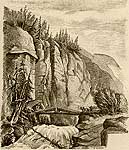
Cauterskill Clove And Profile Rock
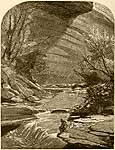
Artists' Grotto, Near The Toll-Gate, Cauterskill Clove
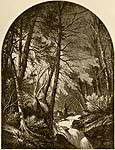
Cauterskill Brook At Dawn |
Still further up, and again turning a corner, we observe a mighty mass of rock arranged in layers. Then we have Profile Rock before us, and at last our way leads over Mores Bridge. The shape of those rocks is quite remarkable, and they seem to be entirely smooth as if artificially polished, and in their sides deep cracks, often extending to a depth of 1500 feet, are visible. They are shaped like towers—at least they appear so when viewed from one side. The road becomes more and more steep, and leads towards the right, passing the Buttermilk Fall.
In the vale below, ruins of houses and of tan mills are visible, calling to mind of the brutal force and cruelty with which once the splendid forests of this country were devastated. The road leads also over the bridge spanning the original Cauterskill brook, which near by here unites with the Haines brook.
Taking at this bridge the road to the right and through the Clove, we reach in, about half-an-hour the Laurel House. The main road is so steep that a horse has enough to do to draw even an empty wagon, Constantly ascending, we at last reach an elevated plain, and a table land extends before us., The Haines Fall flows at the end of the valley over a precipice, and, descending perpendicularly into the depth below, the falling waters sparkle brilliantly, thus presenting magnificent sight. This is the boundary of the valley.
Having reached the Highland, no one should neglect to cast a glance backwards. After reaching a high point at Haines' summer resort, he will then behold the deep clove, and the valley will appear as if it were totally shut in and closed. The whole effect is thus very pretty; the high land has here an elevation of about 2,000 feet. We see right in front of us the South Mountain, and the precipitous rock thereon, called Sunset Rock, recognizable by several gigantic trees, whose upper branches are very luxuriant, standing up there as if hanging in the air, Towards the right the High Peak is seen as if reaching the clouds, and through an aperture in the rocks a good view of the Highland of the Hudson can be secured. The immense distance causes everything to assume a bluish tinge bordered with silver, and the vision becomes lost in the far distance.
We continue our way towards the summer resorts. The road leads in a roundabout direction over a bridge, beneath which fresh spring waters flow gently toward Haines Falls.
Passing the bridge, a sharp corner brings us to the so-called Haines' Corner. The road from here leads over the mountains' peaks, from which the view is truly grand looking. Towards Tannersville and Hunter, the picture in the distance is magnificent.
|
Up in the height, we behold at the left the new Kaaterskill Hotel, looking as charming in the midst of the verdant foliage as any of the most beautiful castles of Europe. Another turn, and somewhat downward through a beautifully-shaded path, and we reach the Laurel House. What a contrast between this house and those "fashionable" houses in the village. This one is situated in a sort of cavity, but it is as airy and cool as can be. It has a reputation for its splendid location; and even if it is warm inside, one can easily remedy his position by stepping out of the house and enjoying the beautiful country surrounding it. There is a splendid old wood right in front of the house, and it seems as if the owner of the hotel and of the country around it, Mr. J. L. Schutt, would well understand and accordingly appreciate the value of a cultivated forest. The forest has the appearance of a beautiful, well-kept park, and pretty pathways traverse it in all directions. At the left, a stairway leads down into the valley, and having descended about 200 feet we suddenly hear the peculiar noise of the waterfall which is near by, and which sounds like the continued reports of a pistol. Having arrived below, an indescribably beautiful sight is before us. The water falling from the height, gives off spray which the winds carry in all directions; the bulk of the water collects itself, and falls over a second precipice into a depth of about 50 feet, where a pretty rustic bridge has been built. Here, near an immense rock, one has the very best opportunity to view the waterfall. Seen from here, it is a most dazzling sight, especially at a time when the rays of the sun break into the falling water.
|
|

Kaaterskill Falls
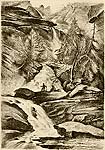
Haines And Five Cascades Falls
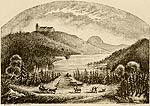
South And North Lakes, With View Of Cauterskill Hotel
|
The noise made by the fall is very loud, as it necessarily must be, considering that the water rolls from a height of 185 feet. The Kaaterskill waterfall is by no means the largest in the world, but in point of picturesqueness, in the beauty of the surrounding country, and the splendor of the scenery, it can not be surpassed by any in nature. It is in fact a double waterfall of the most imposing character. Viewed from above, we see the water flowing with terrible force over the precipice, and it seems as if the falling mass had been converted in mid air into one mighty avalanche of snow, for the foaming and frothing of the water gives to it the color of the falling snow. Many a picture has been taken of this waterfall, and although it is usual, in pictures representing natural sceneries, to make them look more beautiful than in reality they are, it must be said that no picture ever made, representing this scenery, did full justice to it. Not only can art not create a picture more beautiful than the one we see here, but it cannot even approach it. No artist ever succeeded in representing the scene in such beauty as it appears to the astonished eye. It is just as difficult to describe the scenery justly. Again we find here the truth of the oft-repeated assertion that Nature and creation are mightier than even the human heart imagines.
Haines And Five Cascades Falls
Above the Fall one can enjoy a beautiful view of the Cauterskill Clove and an excellent prospect over the plains of the Hudson. Looking down, it appears as if an eruption had excavated or hollowed out the earth below, and had thrown up the rocks lying around there. From its innermost depths these large rocks show the influence of the waters flowing constantly over them, since they are smooth and even;—trunks of what were
once gigantic trees are also seen. How innocent and noiseless is the water falling perpendicularly over the rocks, but how terribly impetuous in its fall into an abyss of 300 feet. In this depth everything bears witness of the irresistible force which the rocks sometimes give to these waters. Inasmuch as the waterfall is very light in summertime, it is a source of wonder to many from whence the brook below springs, and why it is pure spring water, clear as crystal, and a pleasant contrast to the waters of Kaaterskill Fall, which, flowing from the North and South Lakes, are slimy.
These two last-mentioned lakes were at times very much dreaded, and the legend says that snakes and reptiles made their homes in these waters and in the bulrushes of their banks. Now-a-days, no trace of them can be seen, and inasmuch as the whole country here has become a modern roaming ground, even the once magnificent primeval wood has lost all its glory and charms. A beautiful pathway now divides, the two lakes, and no remains of the former wilderness can be found. This evinces the power and skill of human ingenuity, which changes an unapproachable wilderness into a beautiful pleasure ground.
|
|
There is no room for doubt that the ancient legends and stories which are related concerning these two lakes, had at one time been told with some show of justification. Years and. years ago, it must really have been the most forsaken place on earth. The waters of the lake being still impure, trout will not live in it as yet, though efforts have been made to climatize it there. The little stream above the Haines Fall flows in a north-western course towards the high mountains, where the valley expands to a great width, — no trace, not even a bush of the once splendid forest that grew here, can be
found. The little brook we have mentioned is, throughout the whole of her course, exposed to the rays of the sun, and it is really wonderful that a drop of it remains to flow into the fall.
Had the forest of the country not been destroyed, the brook would have remained full of water, and all the year round there would have been sufficient to supply the fall. What will the coming generations say of us if this devastation of the foliage of the land continues? They will ask: Where is the boasted splendor of these mountains; Where is the beautiful Kaaterskill; and where the pretty Haines Falls we read about? Not a drop of water will be found there; barrenness and sand will be left to give evidence of our wantonness and carelessness. Now is the time to consider and to change for the better. All is green and blooming as yet. The air is mellow, sweet and balmy.
|
|
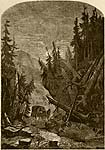
Coming Through The Notch
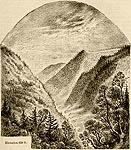
Cauterskill Clove, Between High Peak And South Mountain
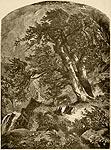
Storm In Cauterskill Clove
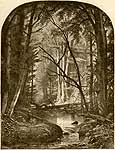
Brook In The Catskills Enclosed By Birch Trees
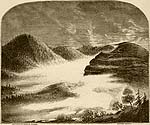
Colonel Chair And Hunter Mountain
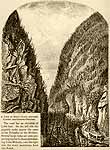
A View In Stony Clove, Between Ulster And Greene Counties
|
And yet, in spite of all, this, must we see the blessing of our country evidently destroyed. Let us hope that more appreciation of Nature's bounty, and that a better spirit will prevail among the inhabitants of this region, for while as yet nature is rich and charming hereabouts, evidences of the evil influence of the destruction carried on are already visible. The time has come when devastation of the forests should be discontinued — nay, when the woods deserve careful and expert nursing. To destroy the woods is a sin against Nature and against mankind!
Standing above Haines Falls, which lies at the close of the deep valley known as Cauterskill Clove, the view over the wide valley which extends over Hunter and Lexington to the Westkill Notch, will give evidence of the devastation of the forest. Viewed from below at its first fall, the height of it appears to be about 100 feet; and the rocks rising in the excavation below, are of gigantic dimensions. The waters fall perpendicularly over these rocks, and especially over a multitude of smaller stones lying around. In. the very midst of the fall is an immensely big rock, which, for a time, entirely hides the water from our view, but the water appears soon again, flowing from rock to rock to the second fall, where it rolls into a depth of over forty feet From here, a stair-road leads the visitor into the depth from the right side to the left, and we descend so far as the ladder will reach, Let every one be warned not to attempt to climb lower, for he endangers the possibility of his safe return. Having arrived below, we take a seat on the rock, and as much in the centre of it as possible. From here one can obtain the best view of the most imposing sight. Looking up, we behold the cliff three to four hundred feet high, growing narrower at the top, and into which the sun's rays but sparingly enter. Just at the entrance of the cliff, beautiful and rich green bushes grow, and the sun-light falling on the verdant foliage, produces a most brilliant effect.
While admiring this scene, we suddenly behold the Five Cascades in their full grandeur, and above is a height almost impossible to reach with the naked eye.
Glancing around and above us in this depth, we involuntary ask: Who has created thee, thou splendid Fall? We praise Thee, oh Almighty! thou wise Creator of the universe! To give a word-picture of this scenery, human language is but too weak.
I have attempted to give as good and as correct a representation as possible, so as to enable the reader to have an approximate idea of how beautiful the scenery is.
But how weak are all human efforts compared to Nature's grandeur. It is commonly
said that the pictures of scenery are exaggerated, and that canvas is patient; but this
is not the case when viewing this picture. Where is the, artist who could, even, after the labor of years, give a thoroughly true picture of nature's beauty, and: the magnificent coloring due to the sun's rays? Thus, both of these waterfalls have their own characteristic beauty, and it is difficult to decide which of these two is the more striking in its effect, and which of these natural wonders is the grander.
Colonel Chair And Hunter Mountain.
This peculiar, elliptical-shaped mountain lies directly in the line of the charming Hunter, and runs lengthwise with the Schoharie-Kill Creek. It has been mentioned previously that the valley lies at a height of about 1,700 feet, and the Colonel Chair Mountain is about 3,000 feet high. From here, therefore, only a little over 1,000 feet are to be ascended, in order to reach the mountain's top, and thus an excellent opportunity is afforded to summer boarders of arriving at the summit without much effort, and thereby gaining a fine view over the neighboring country.
The prospect includes the magnificent Hunter Mountain, rising to a height of over 4,000 feet, and which is hardly two miles away, though Hunter is surrounded by all the signs of modern civilization, it yet possesses an extraordinary amount of romantic and wildly-interesting charms given to it by the neighboring mountains. Excellent pathways lead from it in all directions, so that every point of interest can easily be approached. 'The valley beneath is deep and broad and affords good facilities for farming. This spot is most familiar to tourists, and has been visited as a most popular resort for summer boarders a greater number of seasons than any other part of the Catskills. It is a pity that the farmers of this neighborhood could not appreciate the value of the beautiful forests that once flourished here. They have so thoroughly exterminated all the trees, that now they suffer from want of wood for their building purposes, and are obliged to send to Albany for it. How pleasant and invigorating is the scent of the needle-wood foliage! But where is it now? The picture I have drawn represents the scene in the fog
of a moonlit eve. It was October already, when my daughter and I roamed about here, and the splendid Hunter Mountain was already covered with snow. The picture of the white-capped mountain head glittering in the light of the pale moon, is inexpressibly beautiful, the verdant country above us appears as if studded with diamonds.
|
The winter had set in at an early day, and we had to discontinue our researches in this neighborhood much earlier than we intended. This mountain-head has the peculiar name of Colonel Chair Mountain, showing conclusively that its god-father and christener had but very little poetry within him, and even less appreciation for the beauties of nature. The shape of the mountain is very peculiar. It has the form of an ellipse, and viewed in the later days of the autumn when foliage and bush are destitute of their green coverings, the whole contour of the mountain is most distinctly seen and appreciated. Round. rocky layers encircle the mountain, lending it the appearance of a fort erected by human hands. So illusive is the appearance of these step-like layers, that if we possessed stories of robbers' castles and abodes, as European countries do, one would certainly believe that these layers were artificially built to protect the robbers' nest on the mountain top, just as those on the German mountains in the black forest and on the Rhine were erected by the vassals and the serfs of their warlike inhabitants. What dark and gloomy days were those for Germany, — not much better even at this day — when on every mountain or so, another brave, bold and unscrupulous warrior lived and ruled supreme, where-ever the might of his sword was acknowledged! All these plagues are unknown in this happy land of freedom.
As mentioned above, the ascension of these mountains is much easier at this place than at any other spot; consequently, the tourists have a special liking for it.
The morning is always cool and refreshing, and never damp or sultry, and the atmosphere has a much more recuperating effect than elsewhere.
Ascending this mountain, one can enjoy an elegant view, over the zig-zag-like mountain heads of the surrounding country; and to witness a sunrise or sunset from this place affords a picture of beauty and a grandeur, such as can not be obtained from the Rütli.
The Catskills possess in their great variety of scenery such romantic views as perhaps no other mountainous country can boast of. While enjoying this prospect, we are apt to forget that thousands of feet beneath this misty fog resting on the mountain, mankind is busy in its daily routine. While high up here, we seem to look over the rolling waves of the ocean. At another time, viewed by the bright light of the morning, only the zig-zaglike mountain heads are visible, and it looks as though the rays of sun had gilded them and clad them in their own blending colors. Viewing these pictures, we must acknowledge that creation is mighty, mightier and more inscrutable than a human heart can conceive of. Thousands of the most beautiful pictures of nature can be enjoyed here. He who has any appreciation for natural beauty, will never tire of them, for every day, nay, every hour, changes the scene, and ever and anon, a new picture of the panorama comes into sight. For him who has seen, and is acquainted with, the black forests and Switzerland, and who has viewed. the Catskills, the difference will be but one of the
historical aspects of the country.
From Wikipedia:
Rütli (Grütli in French and Italian) is a mountain meadow on Lake Lucerne, in the Seelisberg municipality of the Swiss canton of Uri. Here the legendary oath of the Rütlischwur first occurred and is remembered as the turning-point in the pursuit of independence. Every August 1st, on the Swiss National Day, the oath is re-enacted to commemorate the forming of the Old Swiss Confederacy.
Land forming the Rütli meadow was bought by the Schweizerische Gemeinnützige Gesellschaft in 1859 in order to preserve its state and, among other reasons, to prohibit the construction of a hotel at the historical site. This non-profit company turned the Rütli over to the government as an inalienable gift. RETURN
|
|
|
|







